The first six ships of the “Condotierri” large group, among which the Luigi Cadorna class, were also the first postwar Italian cruisers to see service. Both classes were different in some points but also shared many similarities, like a 5000+ tons displacement, whereas the following D’Aosta group would almost double that, looking for the best compromise between speed and protection.
Surely, these classes are remembered as the infamous “tin-clad cruisers”. Despite having a full 6-in broadside, they were only designed to take care of French large destroyers. It’s always dangerous to design too specialized ships, history showed it time and again, rather than a good all-around design. In the end, the six “destroyers-hunters” of the 1st and 2nd series were all sunk but one, by luck, as she served as a training ship and minelayer during WW2. Fortunately the navy went to a more conventional, larger, more stable design, better all-around for the following groups.
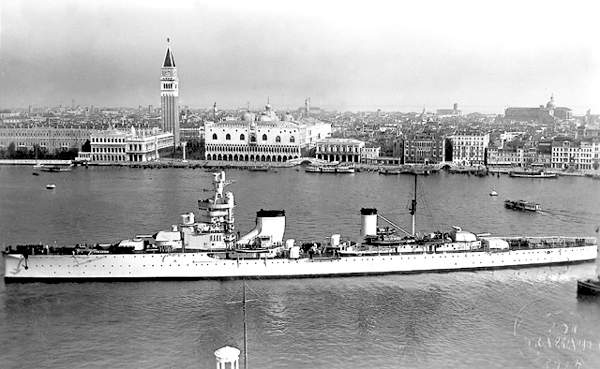
Bartolomeo Colleoni in Venice
The earlier Giussano class: The Guissano
The four cruisers of the Giussano class were the first in the Condottieri serie. These were Albercio da Barbiano, Amberto di Giussano, Bartolomeo Colleoni and Giovanni delle Bande Nere. All four light cruisers were originally designed to catch and destroy the new heavy French destroyers of the Aigle, Jaguar and Lion classes.
They sacrificed everything to reach the greatest speed possible. They indeed broke records on trials, from 39 to 42 knots (Barbiano) earning the title of fastest cruisers worlwide. A gift for Mussolini’s propaganda office, but this masked a woefully inadequate, down to non-existent protection; They were the provierbial “tin-clad cruisers”. Added to this, their tall bridge and low hull compensation made a tall metacentric height, making stability particularly poor. Not only this prevented to keep an effective speed, as they lost it by turning more slowly to avoid capsizing, but this also made them heavy rollers, and bad firing platforms. The main artillery could however deliver on target on these French destroyers, 5 salvoes per minute.
These compromised could be understood for their specialized role, but since France was liminated soon from the game, these defect became detrimental. Tolerated in peacetime, they shown in operations, as in addition the ships were uncomfortable, with poorly designed internal arrangements and a severely limited autonomy. In fact none survived the war. The Bande Nere was sunk by the submarine HMS Urge near Stromboli, the Colleoni in July 1940 by the cruiser Sydney, the Barbiano and Giussano by destroyers HMS Legion, Maori, Sikh and the Dutch destroyer Isaac Swers during the battle of the cape Bon in December 13, 1941. Already their trials revealed a poor stability and the next two of the same class were modified to try to correct these defects. But the philosophy behind the Cadorna was the same: Catching French heavy destroyers.
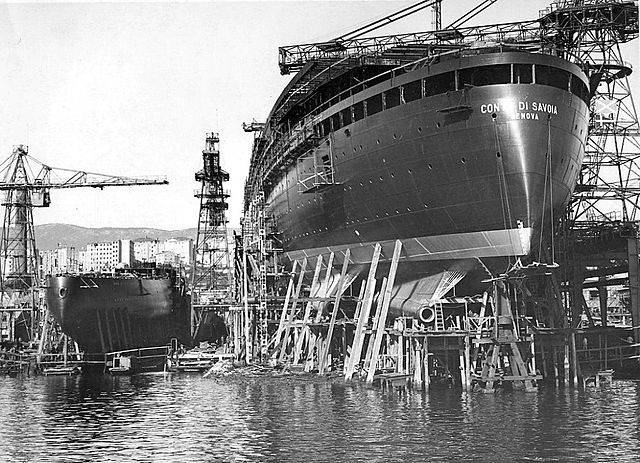
Launch of the Cadorna in Trieste, alongside the liner Conte di Savoia.
Design of the Luigi Cadorna class
The second group Condottieri was very close to the previous Giussano. However they corrected one of the essential defects, the lack of stability. This was done by fitting them with lateral “bulges”, and by lowering superstructures, as well as playing on the distribution of armament. This were however marked by a slight increased displacement, their dimensions remaining the same. They also roomier turrets and were equipped to lay mines, up to 138 taking place of the on rails, but of the smaller Regia Marine model. The Cadorna was displaced 5,323 t (5,239 long tons) standard and 7,113 t (7,001 long tons) full load, so more than the Guissano (6,954 tonnes fully loaded). Their dimensions were similar, at 169.3 m (555 ft 5 in) in overall lenght, a beam of 15.5 m (50 ft 10 in) and a draught of 5.2 m (17 ft 1 in), apparently lower than the Guissano (5.3 m or 17 ft). Coming from different yards, both ships diverged after completion. Diaz was slightly heavier at 5,406 t (5,321 long tons) standard.
Powerplant
Both ships were fitted with two Parsons geared turbines fed by six Yarrow boilers, delivering a total output of 95,000 hp (70,841 kW), the same as the previous Guissano class. The Cadorna was specified to reach 37 knots (43 mph; 69 km/h) as specified, but she managed to reach 39.7 knots on trials. Diaz performed less well at 36.5 knots (42.0 mph; 67.6 km/h). Range was 2,930 nmi (5,430 km) at 16 kn (18 mph; 30 km/h) for Cadorna and better at 3,088 nmi (5,719 km) at 16 kn (18 mph; 30 km/h) for Diaz.
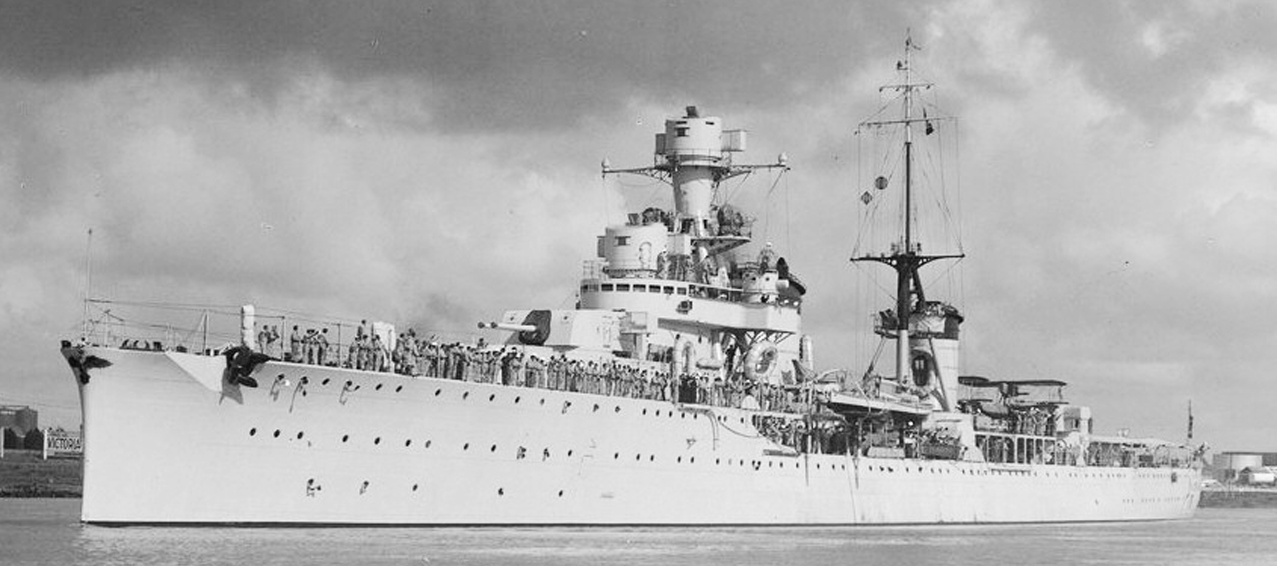
Armament
Both ships were armed the same, and also like the previous Guissano class: The core was four twin turrets, in total eight 152 mm (6 in)/53 guns. These were not independent mounts, both guns were elevated to the same level. However the turrets were modified and rearranged compared to the Guissano and were more spacious. These guns were manufactured in 1926-31 by Ansaldo and OTO Melara. The Guissano had the 1926 gun model while the Cadorna class swapped to the 1929 model. In common they had a jacket with loose liner and horizontal sliding breech block but they differed by the thickness of liner, the size of their breech ring and length of the jacket.
The secondary armament comprised six twin 100 mm (4 in)/47 caliber guns under masks, placed the same way as previous cruisers, either side of the beam and on the superstructure, in front of the rear funnel. These were an Italian version of the Škoda 10 cm K10 made by OTO melara. Dating back from WW1 it was of an obsolete type, more antiship than AA in WW2. It fired a fixed QF ammunition weighting 13.75 kilograms (30.3 lb), while the gun had an horizontal sliding breech block while the mount can elevate -5° to +85°. Average rate of fire was 8-10 rpm, and muzzle velocity was 880 meters per second (2,900 ft/s). Range was 15.2 km (9.4 mi) and Ceiling 10 km (33,000 ft) at 80°.
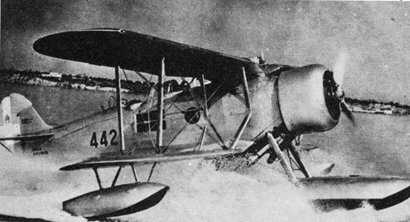
The tertiary armament comprised two single mounted 37 mm (1.5 in)/54 guns and eight (four twin) Breda 13.2 mm/75.5 guns. They were placed in the bridge and supertructures. This was completed by four 533 mm (21 in) torpedo tubes in two beam twin mounts. The Imam Ro43 seaplane installed from 1935 was also armed with 7.7 mm machine guns and posssibly light bombs, but its mission was reconnaissance.
Luigi Cadorna was rearmed in 1944, then one of the very rare Condotierri ships in service with the allies. She received four 20 mm AA on twin mounts, lost her catapult and torpedo tubes to regain more stability. As such, she survived the war, remaining in service until 1951.
Armor protection
Likle the previous ships it was still faily light and the Cadorna serie are unmistably part of the “tin-clad” generation of cruisers. Things really improved with the Vth group – Duca Degli Abruzzi class cruisers. Internal protective deck was 20 mm (0.79 in) in thickness, while it was connected to the main belt 24 mm (0.94 in) strong. Turrets were only given 23 mm (0.91 in) on the frontal arc, which stopped shrapnells, but was vulnerable to all calibers of shells, including those 140 mm of the French heavy Destroyers of the time. Only the conning tower received a more substantial protection with 40 mm walls.
Technical specifications of the Luigi Cadorna class
Displacement 5,230 t. standard; 7,000 t. Full Load
Dimensions: 169,30 m long, 15,50 m wide, 5,50 m draft (555 x 50 x 17 feets)
Machinery: 2 shaft Parsons turbines, 6 Yarrow/Ansaldo boilers, 95,000 shp.
Top speed: 36.5 knots – Range 2,930 nm at 16 knots
Protection: Belt 40, Deck 20, Turrets 23, Blockhouse 40 mm
Armament: 8 x 152mm (6 in) (4×2), 6 x 100mm (4 in) (8 x 2), 8 x 37mm AA, 8 x 13.2mm AA, 4 TLT 533 mm (2×2), 2 floatplanes
Crew size: 544-608 (wartime)
The Luigi Cadorna class in service
Although plagued by the same flimsy contruction than the previous Giussano class, the Cadorna and Diaz were very active and if one was torpedoed in 1941, the other survived the war, the only ship of the whole early Condotierre group.
Luigi Cadorna
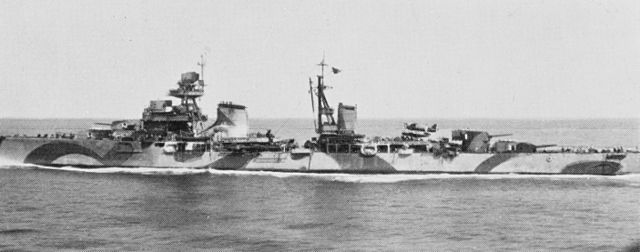
Luigi Cadorna, camouflaged, surrendering to the allies at Malta, 9 November 1943
The Italian light cruiser, ordered on 29 October 1929 was laid down at CRDA, Trieste (Adriatic coast) on 19 September 1930, launched one year later in 30 September 1931, but completed 11 August 1933 so roughly over a construction period of three years, which was slightly above average.
She was named after Italian Field Marshal Luigi Cadorna, commander in Chief of the Italian Army. Nowadays widely criticized for his conduct of operations and failures, but at that time, the honored generalissimo of the Italian Army.
Cadorna’s early service were spent during the Spanish Civil War, patrolling maritime trade routes in concert with other nations and supporting the Italian contingent which was sent here. In April 1939 she participated in the occupation of Albania, by covering the landings. They were sent to deal with the port of Durrës, destroying the little naval forces the Albanians had and covering the landings.
When the second world war broke out, she was part of the 4th Cruiser Division. Her first mission was to lay mines on 9 June 1940 off Lampedusa island. She was part of the Italian line at the Battle of Calabria, avoiding a submarine torpedo attack, but repelling allied planes and assisting the Armando Diaz plagued by boiler problems.
In February 1941 Luigi Cadorna went into reserve as the admiralty judged the class too frail to take part in further operations. Nevertheless, pressing situation force the admiraty to recall them when the Axis supply road in North Africa was threatened. Luigi Cadorna watched over convoys heading towards North Africa. In between she made a sortie to try to intercept British convoys to Malta. In By November to December 1941 she transported herself fuel and ammunition to Libya.
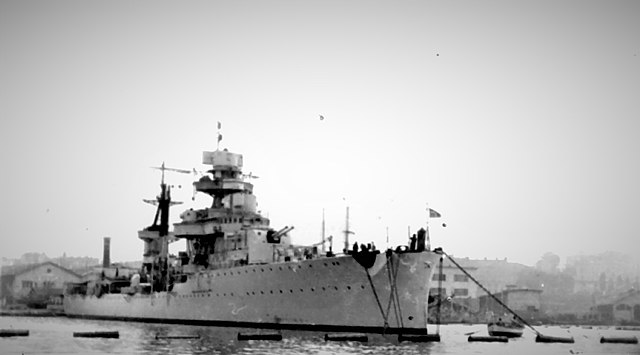
Luigi Cadorna in Pola, 1940.
From January 1942 she was sent to Pola as a training ship. She received a short refit in May-June 1942 and joined the 8th Cruiser Division. Until the end of June she carried troops to Albania. On 3 July 1942 she sailed to her new base of Taranto, and from this, started a serie of five minelaying missions. The goal was create defensive minfields in the Gulf of Taranto. She was assisted by the brand new Scipione Africano, a light/cruiser also dubbed “super-destroyer”, which just entered service.
The armistice came on 8 September 1943. At that time, Luigi Cadorna was still stationed at Taranto. Like the rest of the fleet, she sailed to Malta to surrender the 9, according to the surrender negociations. On 14 September however she was tranferred to Alexandria and later in October 1944 she returned to Taranto, to be used as a transport ship for the Allies, also repatriating Italian troops from various theaters of operations. According to the Peace Treaty of 10 February 1947 she as not offered as a war prize but remained in the Italian Navy, and served as a training ship until May 1951. She was subsequentely stricken and scrapped afterwards, the only early Condotierre cruiser to survive the war.
Armando Diaz
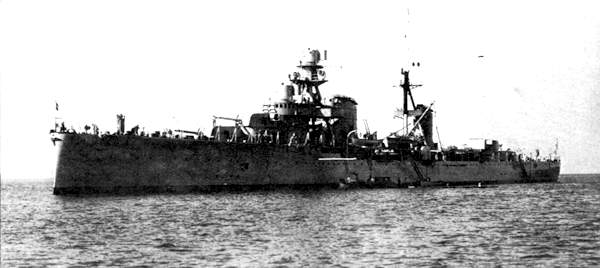
Armando Diaz was built by OTO, Muggiano (La Spezia), and named after an Italian Field Marshal of World War I. She served in the Mediterranean but on 1 September 1934 and until February 1935, she toured the woorls, reached the Pacific and visited Australia and New Zealand. When the Spanish Civil War broke out in 1936, she patrolled the trade lanes in the western Mediterranean, based at Palina and Melilla.
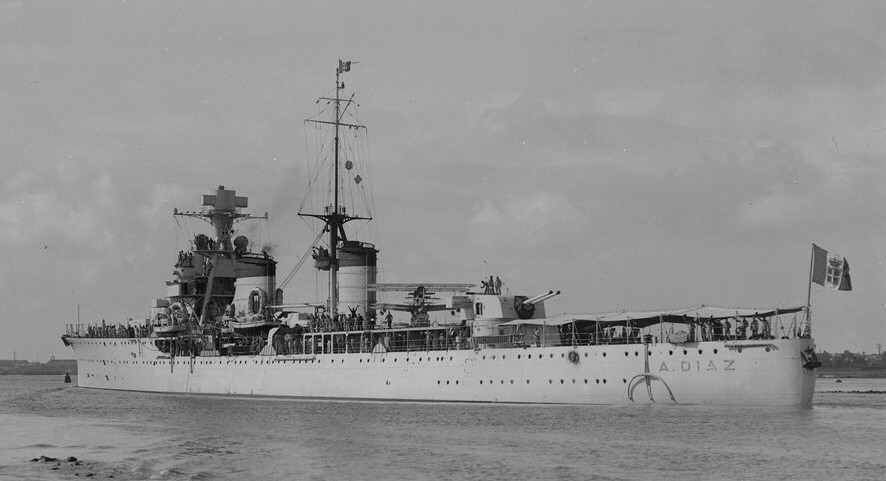
Armando Diaz prewar, stern view.
The second world war broke out, and Diaz participated in July 1940, to the Battle of Calabria (Punta Stilo). She was not hit noe hit any British ship during the action, largely inconclusive. In October 1940 she was sent to Albania, supporting landing troops here. In December 1940 she was placed under command of Supermarina (the Regia Marina supreme naval Headquarters). She was to protect traffic to Albania from January 1941 but was soon required, in January 1942, to cover an important supply convoy to Tripoli. She teamed with another ‘tin-clad’ cruiser for the occasions, the Giovanni dalle Bande Nere, plus some destroyers. During this operation however she was spotted, torpedoed and sunk by the British submarine HMS Upright, posted off the island of Kerkennah on 25 February. The Armando Diaz’s hull ruptured in two after her magazine blew up, resulting her to sink under only six minutes, carrying with her 484 sailors and officers, the 4/5 of her entire crew.

Old Illustration of the Cadorna class by the author.

2-view drawing of the class (cc)
Read More & notes
Conway’s all the world’s ships 1922-47
http://www.marina.difesa.it/EN/history/Pagine/ufficiostorico.aspx
The Cadorna On navypedia
Armando Diaz – Incrociatore leggero, su marina.difesa.it.
Condottieri Class Cruisers – LCC Books
//www.world-war.co.uk/italy/luigi.php3
comandosupremo.com – condottieri-class-cruisers/
I motti delle navi italiane, Roma, Ufficio Storico della Marina Militare, 1962, pp.36.
Giorgio Giorgerini, La guerra italiana sul mare. La Marina fra vittoria e sconfitta 1940-1943, p. 172-180
Gianni Rocca, Fucilate gli ammiragli. La tragedia della Marina italiana nella seconda guerra mondiale, p.98
Giorgio Giorgerini, La guerra italiana sul mare. La Marina fra vittoria e sconfitta 1940-1943

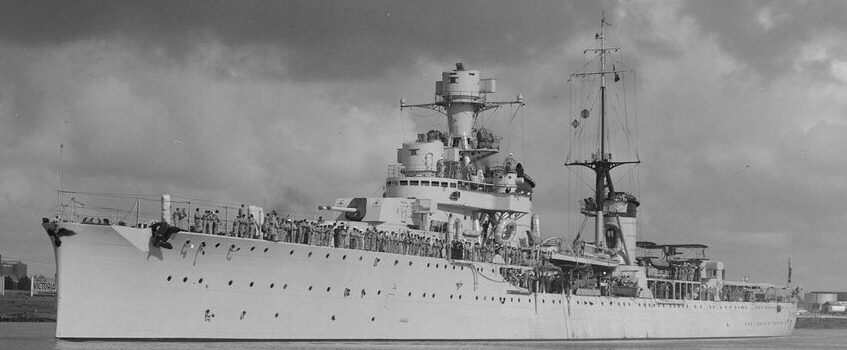


 Latest Facebook Entry -
Latest Facebook Entry -  X(Tweeter) Naval Encyclopedia's deck archive
X(Tweeter) Naval Encyclopedia's deck archive Instagram (@navalencyc)
Instagram (@navalencyc)





 French Navy
French Navy Royal Navy
Royal Navy Russian Navy
Russian Navy Armada Espanola
Armada Espanola Austrian Navy
Austrian Navy K.u.K. Kriegsmarine
K.u.K. Kriegsmarine Dansk Marine
Dansk Marine Nautiko Hellenon
Nautiko Hellenon Koninklije Marine 1870
Koninklije Marine 1870 Marinha do Brasil
Marinha do Brasil Osmanlı Donanması
Osmanlı Donanması Marina Do Peru
Marina Do Peru Marinha do Portugal
Marinha do Portugal Regia Marina 1870
Regia Marina 1870 Nihhon Kaigun 1870
Nihhon Kaigun 1870 Preußische Marine 1870
Preußische Marine 1870 Russkiy Flot 1870
Russkiy Flot 1870 Svenska marinen
Svenska marinen Søværnet
Søværnet Union Navy
Union Navy Confederate Navy
Confederate Navy Armada de Argentina
Armada de Argentina Imperial Chinese Navy
Imperial Chinese Navy Marinha do Portugal
Marinha do Portugal Mexico
Mexico Kaiserliche Marine
Kaiserliche Marine 1898 US Navy
1898 US Navy Sovietskiy Flot
Sovietskiy Flot Royal Canadian Navy
Royal Canadian Navy Royal Australian Navy
Royal Australian Navy RNZN Fleet
RNZN Fleet Chinese Navy 1937
Chinese Navy 1937 Kriegsmarine
Kriegsmarine Chilean Navy
Chilean Navy Danish Navy
Danish Navy Finnish Navy
Finnish Navy Hellenic Navy
Hellenic Navy Polish Navy
Polish Navy Romanian Navy
Romanian Navy Turkish Navy
Turkish Navy Royal Yugoslav Navy
Royal Yugoslav Navy Royal Thai Navy
Royal Thai Navy Minor Navies
Minor Navies Albania
Albania Austria
Austria Belgium
Belgium Columbia
Columbia Costa Rica
Costa Rica Cuba
Cuba Czechoslovakia
Czechoslovakia Dominican Republic
Dominican Republic Haiti
Haiti Hungary
Hungary Honduras
Honduras Estonia
Estonia Iceland
Iceland Eire
Eire Equador
Equador Iran
Iran Iraq
Iraq Latvia
Latvia Liberia
Liberia Lithuania
Lithuania Mandchukuo
Mandchukuo Morocco
Morocco Nicaragua
Nicaragua Persia
Persia San Salvador
San Salvador Sarawak
Sarawak Uruguay
Uruguay Venezuela
Venezuela Zanzibar
Zanzibar Warsaw Pact Navies
Warsaw Pact Navies Bulgaria
Bulgaria Hungary
Hungary

 Bundesmarine
Bundesmarine Dutch Navy
Dutch Navy Hellenic Navy
Hellenic Navy Marina Militare
Marina Militare Yugoslav Navy
Yugoslav Navy Chinese Navy
Chinese Navy Indian Navy
Indian Navy Indonesian Navy
Indonesian Navy JMSDF
JMSDF North Korean Navy
North Korean Navy Pakistani Navy
Pakistani Navy Philippines Navy
Philippines Navy ROKN
ROKN Rep. of Singapore Navy
Rep. of Singapore Navy Taiwanese Navy
Taiwanese Navy IDF Navy
IDF Navy Saudi Navy
Saudi Navy Royal New Zealand Navy
Royal New Zealand Navy Egyptian Navy
Egyptian Navy South African Navy
South African Navy






























 Ukrainian Navy
Ukrainian Navy dbodesign
dbodesign